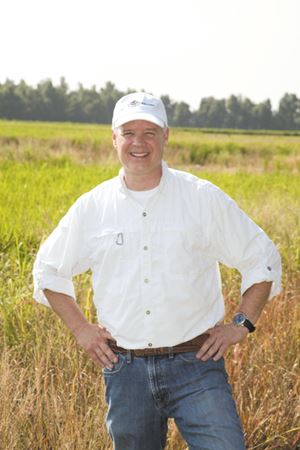|
Quality Rice
USRPA Rep Says Quality Matters In Rice Production
BETTY VALLE GEGG-NAEGER
MidAmerica Farmer Grower
MALDEN, MO.
International marketing is one of the main programs of the U.S. Rice Producers (USRPA), with Greg Yielding, USRPA rep, leading that project. He also is a representative of the Missouri Rice Council.

Greg Yielding, representative for USRPA and the Missouri Rice Council, discusses how international marketing is one of the main programs of the U.S. Rice Producers.
Photo by John LaRose, Jr.
“We have been focusing on China, Mexico, and Central America,” he said. “At this time we have many programs in Mexico, with Mexico and Central America being our biggest market, mainly rough rice market. However, we need to increase consumption in those markets and we need to make sure we continue to have good markets in those areas.”
He explained USRPA works with schools and supermarkets to increase consumption and teach people about rice. Those are mainly corn-based societies.
“We want to increase the consumption because there’s a lot of room for growth and bigger markets will help the farmer and those are the closest markets to us,” Yielding said.
He also commented on China, which is the largest rice market in the world.
“China is the largest rice producer in the world but China also is the largest rice consumer. In recent years, China has been importing rice in vast amounts. We are now working and have been working since 2005 to get protocols established so the United States can export rice to China. China is interested in high quality rice not just normal bulk loads of rice that you might send to other countries with a lot of brokens. They’re interested in the highest quality we can produce and their people will buy it and it will command a premium price in China.
He said the U.S. Rice Producers are working hard to open that market and get these protocols established.
“Recently, I was on a trade mission to China with the Missouri Department of Agriculture where we met with government officials, more supermarkets, and importers and second tier cities,” Yielding reported. “You might ask what a second tier city is. A second tier city is a city with only 8 million to 10 million people instead of 40 million people. So by the standards of the United States, it’s a lot different. All we could produce couldn’t feed them for more than 15 to 16 days so there’s a great opportunity there to sell a lot of rice.”
While the group was at a field day at the Missouri Rice Research Farm in Malden to learn about new varieties and how to be better producers, Yielding stressed that producers must learn first how to produce quality.
“The rice has to be quality, not only for international markets but for markets here in the United States. And that’s what we’re striving for – the high quality rice; and if we can produce that we can keep our international markets and we can also grow consumption here in the United States,” he summed.∆
BETTY VALLE GEGG-NAEGER: Senior Staff Writer, MidAmerica Farmer Grower
|
|